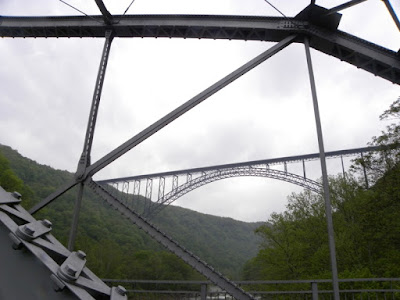
Who's to say the birding excitement ends when you come home from a festival? Not me! The echoing thunder outside says it's time to sit down and
blog.
The most exciting birds are the Cooper's Hawks who are establishing a nest in the pine tree next door. Last month, I could have sworn I saw a pair of Crows going in and out of that nest. In our absence, I guess the Crows abandoned the nest, or got chased off by the hawks. Hmm, I thought that scenario usually went the other way, with the Crows being the aggressor. Aren't these two beautiful?

I don't think they actually have eggs yet. The female seems to spend a lot of time in the oak. When another Cooper's flew high overhead, she hurried back to her nest to defend it though, eggs or not. This morning she was standing on the edge, surveying the neighborhood. It's fun to hear them talk back and forth to each other. I don't think the human neighbors have any idea of the honor being bestowed on them.

All right, here we go. Hold your breath, 1,2,3....
Our new creek is full to the brim from all the rain in the last 2 weeks. This Robin has decided the creek is just right for bathing.
 Brrrrrrrr!
Brrrrrrrr!

I discovered a new park nearby with wonderful birding opportunities in the marsh and wetlands surrounding Beargrass Creek, as it winds through the St. Matthews neighborhood in Louisville. In the midst of apartment complexes, office buildings, shopping malls and car dealerships, the city finally decided to preserve some of the wetlands for a change. It's really the sensible thing to do since Beargrass Creek floods whenever it rains more than 2 inches. In just a little over an hour this morning, I saw 31 species there, including 5 warblers that I located and identified myself-- a major accomplishment for a former warbler-phobe! Now if we could just convince them to perch for a few minutes it would be great!

I found two mystery birds. The first was someone's escaped parakeet, playing with the big boys. The second is this one. Any suggestions out there? This is why I never wanted to look for warblers. Or is this some non-warbler?

Every play hide and seek with a squirrel? This is like the child who thinks you can't see him because his head is hidden! If the sun ever comes out again, I'm going back to this park to see what else I can find.
PS...
After about 13 weeks the city finally picked up the brush from the ice storm, as promised. YEAH!
 Several pairs of Barn Swallows nest under the porch roof of the Garden Pavilion at Bernheim Forest. Maybe we should call them "Bern Swallows" instead. Don't you just love these little faces peering over the nest edge? They still have little fuzzies on their heads. Awww...
Several pairs of Barn Swallows nest under the porch roof of the Garden Pavilion at Bernheim Forest. Maybe we should call them "Bern Swallows" instead. Don't you just love these little faces peering over the nest edge? They still have little fuzzies on their heads. Awww...
 Proud Papa protects his family, and we got dive-bombed
until we made a tactful and hasty retreat.
Proud Papa protects his family, and we got dive-bombed
until we made a tactful and hasty retreat.
 Well, Ma, I chased them away. Don't know
why these durn people never learn!
Well, Ma, I chased them away. Don't know
why these durn people never learn!
 Here's our neighbor, still sitting on her eggs.
Here's our neighbor, still sitting on her eggs.  Crows just like to chase hawks for the fun of it.
Crows just like to chase hawks for the fun of it.
 The Goose family enjoy Sunday morning brunch at Bernheim Forest.
My, my, don't the children grow up quickly!
The Goose family enjoy Sunday morning brunch at Bernheim Forest.
My, my, don't the children grow up quickly!
 Papa Brown Thrasher watches to make sure
we don't get to close to his mate and nest in the bushes.
Papa Brown Thrasher watches to make sure
we don't get to close to his mate and nest in the bushes.
 A Bernheim Ent has issues with a No Trespassing sign.
Not sure if he's for it or agin' it!
A Bernheim Ent has issues with a No Trespassing sign.
Not sure if he's for it or agin' it!














































